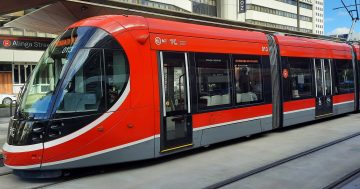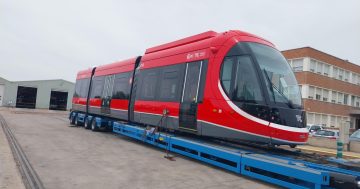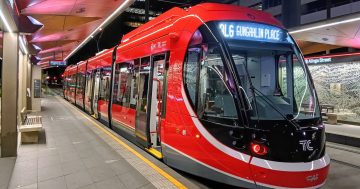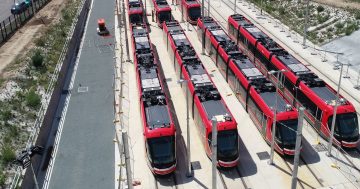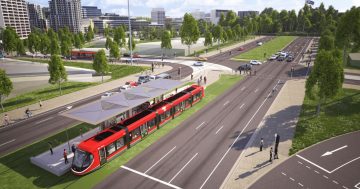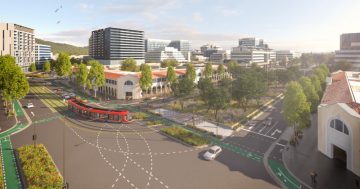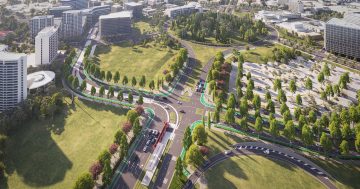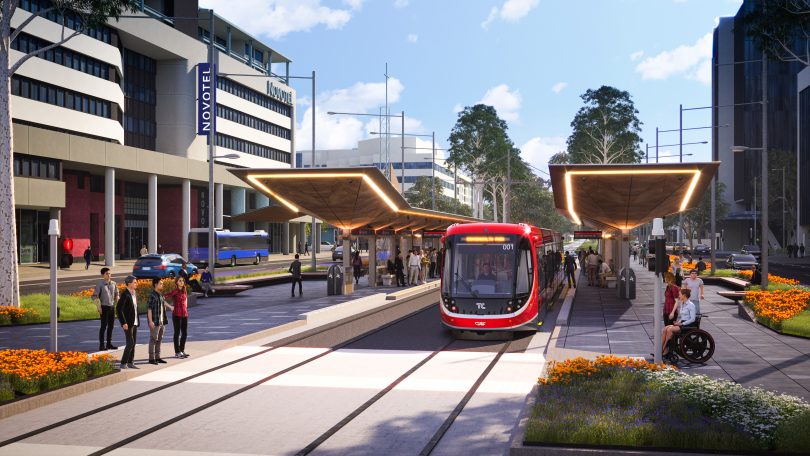
A light rail vehicle heads out wire-free from the Alinga Street Station. Images: ACT Government.
It should not have come as a surprise that the ACT Government would opt for a wire-free run to Commonwealth Park from the city for the next stage of light rail.
Both the business case and the EPBC documents lodged with the Federal environment department canvassed wire-free sections of the Stage 2 route in response to demands from the National Capital Authority that heritage vistas and the areas of national significance in the Parliamentary Triangle not be adversely impacted by unsightly poles and wires.
The EPBC documents in particular present the 1.7 km City to Commonwealth Park leg as a self-contained wire-free proposal, with light rail vehicles charging at the three new stops of City West, West Basin and Commonwealth Park.
The confirmation that Stage 2A will be wire-free means a higher price-tag as new and existing light rail vehicles will need to be fitted with onboard energy storage with regenerative braking capability, as well as a traction power substation connected to the system at Commonwealth Avenue having to be built in Commonwealth Park.
While tracks will be laid in the middle of London Circuit once the light rail turns into Commonwealth Avenue, they will be on the grassed median down to Commonwealth Park.
How much extra going wire-free will cost cannot be revealed as the ACT Government is still negotiating the deal with Stage 1 operator Canberra Metro to construct and run Stage 2A, although one expert put the premium at 20 per cent extra per vehicle.
Transport Minister Chris Steel insists it is not prohibitive, but Chief Minister Andrew Barr had expressed some caution at the cost, preferring that wire-free running be limited to sections where it was essential.
But in order to keep the NCA onside and secure approvals for the longer and more complex Stage 2B to Woden, the Government has decided it’s a price worth paying. It also makes sense to make the whole 1.7 km wire-free rather than switch at the Commonwealth Avenue turn.
Associate Professor Matthew Burke from the Cities Research Institute at Griffith University told the ABC the ACT Government had been wedged.
“The NCA’s made it pretty clear they don’t want an operation with catenary (the wires) and they’ve really forced their hand to run with a battery tram,” he said.
At this rate, we could see wire-free running all the way to the Lodge on Adelaide Avenue.
It is understandable therefore that the ACT Government should be looking to the Commonwealth, if it is making demands that will mean extra costs, to contribute to the bill.
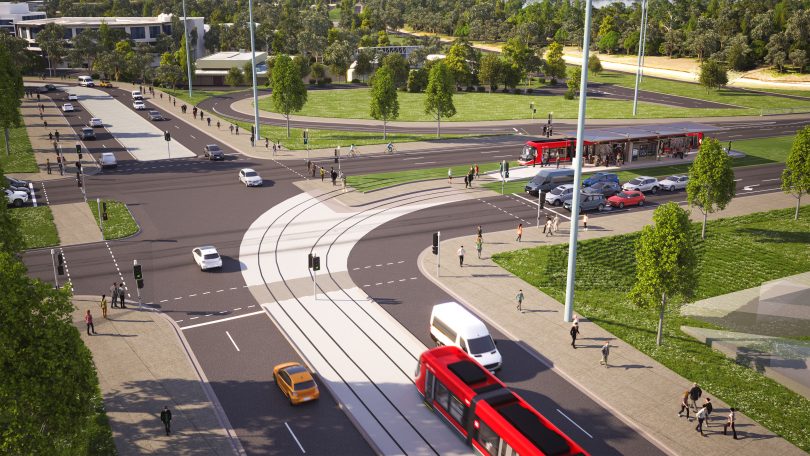
The turn into Commonwealth Avenue from a raised London Circuit on to the grassed tracks for the run down to the lake.
This is besides the fact that a major public transport project in the nation’s capital that will serve the Commonwealth’s own workforce should attract some co-funding, particularly if the Morrison Government needs to stimulate a flagging national economy come Budget time.
The Canberra Liberals, while acknowledging the popularity of Stage 1, remain loath to back Stage 2, saying they want to see the numbers before making any commitment.
This has drawn the ire of the Public Transport Association of Canberra which called on the Opposition to outline their plans for bringing light rail to Woden ahead of the Territory election in October.
But the wire-free decision could see the Liberals flirt even more with the evolving trackless trams technology, touted to be a much cheaper option than rail after their transport spokesperson Candice Burch talked it up in the Assembly last year.
Promoted by Curtin University sustainability expert Professor Peter Newman, the Chinese autonomous rail transit, or ART, is an electric articulated vehicle on rubber wheels that runs in dedicated lanes.
PTACBR chair Ryan Hemsley has derided the technology as a novelty electric bus.
“Once you factor in the costs of constructing an exclusive right of way, inclusive of utilities relocation, concrete trackbed, accessible stops and recharging points, what you will be left with is an unproven piece of technology, locked into a single supplier with no discernable cost advantage over light rail. These ‘trackless scams’ offer the worst of all possible worlds and should not be given serious consideration by the ACT Government,” he says.
There are also concerns about how the lack of route permanence impacts on the residential and commercial development potential that light rail is designed to unlock.
But there is no chance now that the Government will change tack and it will want to have contracts in the bag before its October date with the electorate so it can go into the campaign with Stage 2A locked down and maybe even underway.
For ACT taxpayers, it would be a good thing if the Feds cough up part of the bill.












